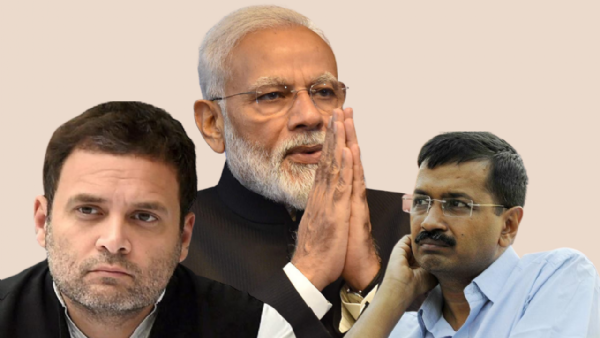AAP and National alternative
Firstly, let me acknowledge the fact that AAP has secured a phenomenal victory in the recent Punjab assembly election. They managed to secure 92 seats in the state with 117 total assembly seats. They also managed to secure a whopping 42% votes in this election. This is a significant achievement as AAP is only the 4th party in India’s electoral history to have 2 sitting CMs. Previously only BJP, Congress and CPM had achieved this feat. Looking at this achievement it is understandable to think that AAP can be
Total Views |
The emergence of AAP in Punjab has evoked reactions across the political spectrum. Some BJP supporters are looking at this development as a threat, because they perceive AAP to be a much tougher opponent than the Congress party. While anti BJP forces are delighted to finally see a party which has finally emerged as an alternative to the congress on the national level, from their perspective. My argument through this article will be that AAP cannot be a national alternative to the Congress Party as the primary opposition party.

Firstly, let me acknowledge the fact that AAP has secured a phenomenal victory in the recent Punjab assembly election. They managed to secure 92 seats in the state with 117 total assembly seats. They also managed to secure a whopping 42% votes in this election. This is a significant achievement as AAP is only the 4th party in India’s electoral history to have 2 sitting CMs. Previously only BJP, Congress and CPM had achieved this feat. Looking at this achievement it is understandable to think that AAP can be a national alternative. But I would advise caution before landing on this conclusion. There are certain factors which have to be met for the AAP to get a majority.
AAP has now formed governments in Delhi and Punjab. On both these occasions AAP needed 2 things to happen simultaneously. On both the occasions AAP victory was preceded by a movement/protest. From 2011 onwards there was a massive campaign against UPA-2’s corruption. Arvind Kejriwal was one of the leaders of that campaign. By 2013 Arvind kejriwal along with a few leaders of that movement tried to ride on anti corruption sentiment against the congress party at the protest site of Delhi NCR. Anti corruption movement was absolutely necessary for the rise of AAP, without which AAP being a political party was impossible. Although they didn't secure a majority, nor did they become the single largest party in that election. But as the Congress party gave their unconditional support to their government, Congress lost its credibility in the state. Remember, Arvind Kejriwal contested against Sheila Dikshit then CM of the state and defeated her. After that infamous 49 day long government and resignation from balcony, AAP managed to secure a humongous majority in the state with 67/70 seats and over 54% votes. This was a direct result of Congress suicide in 2013 in the state. As congress vote share fell from 25% to less than 10% with 0 seats. This collapse of an established party in the state and a movement against the ‘establishment’ were 2 main factors behind AAP’s rise in Delhi. Which AAP successfully maintained in 2020 as Cong vote share fell further to less than 5%. Which is why even though BJP’s vote share increased by more than 6%, from 32% to 38.5%. AAP still secured 62/70 seats.
In Punjab, Shiromani Akali Dal (SAD) and the Congress party used to be in power for 5 years each since 1992. In 2012 for the first time the SAD-BJP alliance managed to get a majority for a consecutive second term. By 2017, anti-incumbency against that government was at its peak. At that time AAP could not win that election, despite many analysts predicting their victory. They could only secure 20/117 seats. In 2022 however, AAP swept. Just like in Delhi, AAP victory was preceded by a massive year long farmers' protest mostly from Punjab, mostly from Malwa region. The AAP government in Delhi supported these protestors in all ways possible. This created a soft corner towards the AAP within the farmers community. Farmers could see AAP’s advertising all the time during protests, which they could not in their home state. Most of these farmers did not really enter the Delhi NCR region to actually look at the work done by the AAP government. Hence their perception of the AAP government was largely based on AAP’s advertisements. This benefitted AAP in a big way. AAP swept the Malwa region, winning 66/69 seats. Another factor was the fall of Congress vote share due to anti-incumbency and infighting. Congress party changed their CM Capt. Amarinder Singh 6 months before the election. Amarinder Singh formed his own party Punjab Lok Congress and formed an alliance with the BJP. Even after this their new CM Charanjit Singh Channi and their state president Navjot Singh Siddhu were fighting publicly ever since. As a result congress’s voter share shrunk by over 15.5%, from 39% to 23%. This was the first time since 1997 that the congress party got less than 25% votes. Coincidently, even in 1997, Capt. Amarinder Singh had formed his own party Shiromani Akali Dal (Panthic). In 2022, SAD also faced the anti establishment brunt and reduction in their vote share of over 6%. SAD got just 18% votes. Which is there worst ever performance after 1992, which was just after Khalistan terrorism in the state. With the decimation of two established parties and Farmers’ protest, AAP managed to win this election handsomely.
Also Read: Akhilesh's Mamata, Kejriwal pattern
For AAP to emerge as a national alternative. AAP has to defeat the BJP government in any state, which they haven't been able to do yet. There are 6 states in India where there is a direct contest between BJP and Congress, where smaller parties are distant third with less than 10% votes. Gujarat, Rajasthan, Madhya Pradesh, Chhattisgarh, Himachal Pradesh, Uttarakhand. In 4/6 states BJP is incumbent and in Rajasthan and Chhattisgarh BJP is a very strong opposition. There are exactly 100 seats in these states. In the 2019 Lok Sabha elections, BJP won 97/100 seats. For AAP to be a national alternative, AAP has to make inroads on these 97 seats. Again, AAP has never defeated a BJP government. They have never even defeated a single incumbent BJP MP. It is one thing to defeat a weak congress and a completely different thing to defeat BJP with PM Modi at the helm. That is the herculean task in front of the AAP.
AAP needs a movement/protest as well as decimation of an existing political party to gain ground in any state. Till now AAP has managed to do so only in states with bipolar contests. It would be even more difficult for AAP to enter multi polar contests like UP, Bihar, Maharashtra, Karnataka. These are the 4 states from which BJP got 130 MPs in 2019. Which is why for AAP to replace Congress and emerge as the primary opposition party is not just difficult but extremely difficult.


